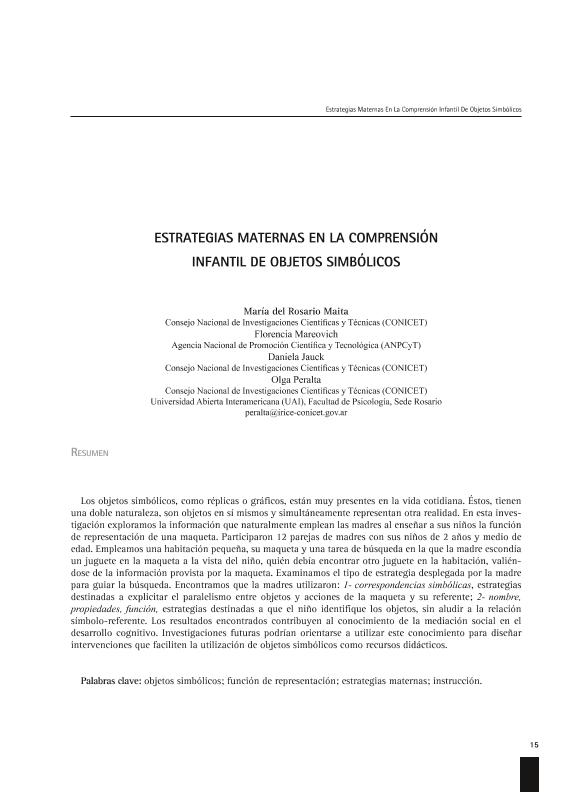Artículo
Los objetos simbólicos, como réplicas o gráficos, están muy presentes en la vida cotidiana. Los mismos tienen una doble naturaleza, son objetos en sí mismos y simultáneamente representan otra realidad. En esta investigación exploramos la información que naturalmente emplean las madres al enseñar a sus niños la función de representación de una maqueta. Participaron 12 parejas de madres con sus niños de 2 años y medio de edad. Empleamos una habitación pequeña, su maqueta y una tarea de búsqueda en la que la madre escondía un juguete en la maqueta a la vista del el niño quién debía encontrar otro juguete en la habitación a valiéndose de la información provista por la maqueta. Examinamos el tipo de estrategia desplegada por la madre para guiar la búsqueda. Encontramos que la madres utilizaron: 1- correspondencias simbólicas, estrategias destinadas a explicitar el paralelismo entre objetos y acciones de la maqueta y su referente; 2- nombre, propiedades, función, estrategias destinadas a que el niño identifique los objetos, sin aludir a la relación símbolo-referente. Los resultados encontrados contribuyen al conocimiento de la mediación social en el desarrollo cognitivo. Investigaciones futuras podrían orientarse a utilizar este conocimiento para diseñar intervenciones que faciliten la utilización de objetos simbólicos como recursos didácticos. Symbolic objects, like models or graphs, are present in everyday life. They have a double nature, as they are objects in their own right and at the same time, represent other reality. In this research we explore the information that mothers naturally employ when teaching their children the representational function of a scale model. Twelve mothers and their 2.5-year-old children participated. We employed a small room, its scale-model and a search task in which the mother hid a toy in the scale-model, the child watched the event, then, the child had to find another toy in the room using the information provided by the scalemodel. We examined the type of strategies mothers used to guide the search. We found that mothers used: 1- symbolic correspondences: strategies aimed at making explicit the parallelisms between the objects and events in both spaces; 2- name, properties, function: strategies aimed at the identification of the objects, without mentioning the symbol-referent relation. The results found contribute to the understanding of the social mediation in cognitive development. Future research could be oriented at using this knowledge in the design of interventions aimed at facilitating the utilization of symbolic objects as didactic resources.
Estrategias Maternas en la Comprensión Infantil de Objetos Simbólicos
Fecha de publicación:
09/2012
Editorial:
Universidad Abierta Interamericana
Revista:
Psicología del Desarrollo
ISSN:
1853-8746
Idioma:
Español
Tipo de recurso:
Artículo publicado
Clasificación temática:
Resumen
Archivos asociados
Licencia
Identificadores
Colecciones
Articulos(IRICE)
Articulos de INST.ROSARIO DE INVEST.EN CS.DE LA EDUC. (I)
Articulos de INST.ROSARIO DE INVEST.EN CS.DE LA EDUC. (I)
Citación
Maita, María del Rosario; Mareovich, Florencia; Jauck, Daniela Eva; Peralta, Olga Alicia; Estrategias Maternas en la Comprensión Infantil de Objetos Simbólicos; Universidad Abierta Interamericana; Psicología del Desarrollo; 1; 2; 9-2012; 17-26
Compartir




